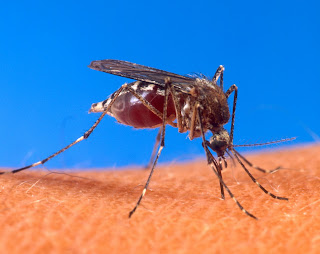 |
| Mosquito (Aedes aegypti) Photo by USDA |
Dengue virus
(DENV) is one of the world’s fastest growing health problems. Each year,
about 500,000 dengue infected people are admitted to the hospital with
life-threatening symptoms, including gastrointestinal bleeding, seizures, and
slow heart rate. More alarmingly, no vaccine or treatment is available
for those infected. DENV is spread by mosquitoes, much like malaria and
West Nile virus. Therefore, controlling
the mosquito vector remains the primary defense against dengue. While
DENV causes illness in humans, researchers have uncovered different effects in
the mosquito that may impact viral transmission.
In order to be
transmitted to a human host, DENV must first infect a female mosquito’s salivary
glands. These glands contain compounds
that help the insect feed. It would be
in the virus’ best interest to encourage the presence of these compounds to increase
transmission rates. Therefore, scientists
wanted to investigate any changes in the salivary glands during DENV infection.
To detect any
changes, researchers screened the entire genome looking for differences in expression
of individual genes in DENV infected mosquitoes compared to healthy
mosquitoes. They found a total of 147
genes being regulated by DENV. Most of
these genes were involved in the immune response, food digestion, and
metabolism. However, there were a few
surprising genes being regulated by DENV.
These genes are actually involved making proteins that bind odorant,
allowing the insect to detect odors. Scientists
engineered mosquitoes that could never express these specific odor binding
protein genes. These insects took
significantly longer to find and bite their host.
This suggests
that by increasing the expression of these odor binding proteins, the insects
will be able to detect their hosts more quickly, resulting in better
transmission of the virus. This is the
first hint that human pathogens may be able to increase their transmission by affecting
the behavior of their vector animal.

No comments:
Post a Comment